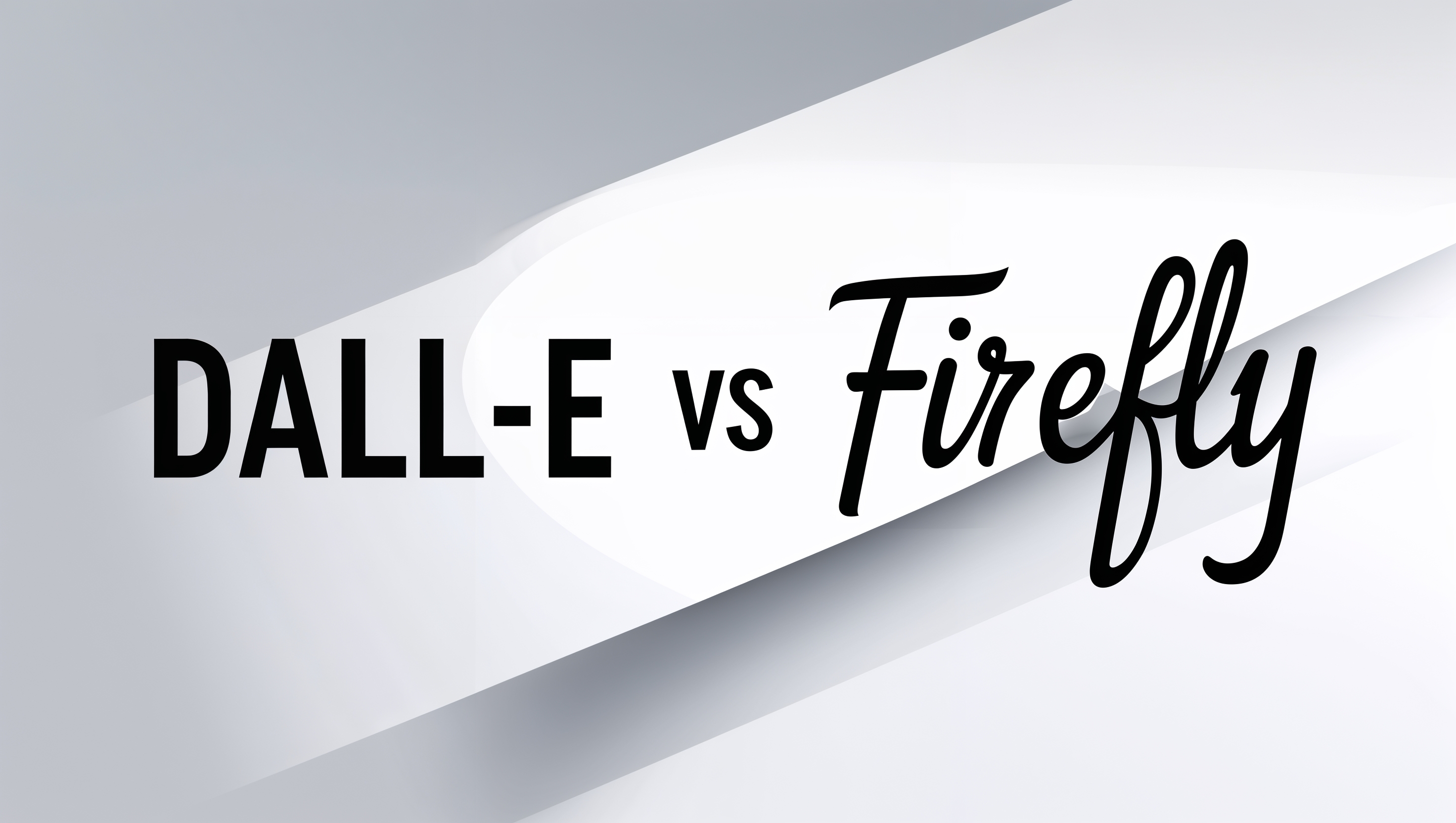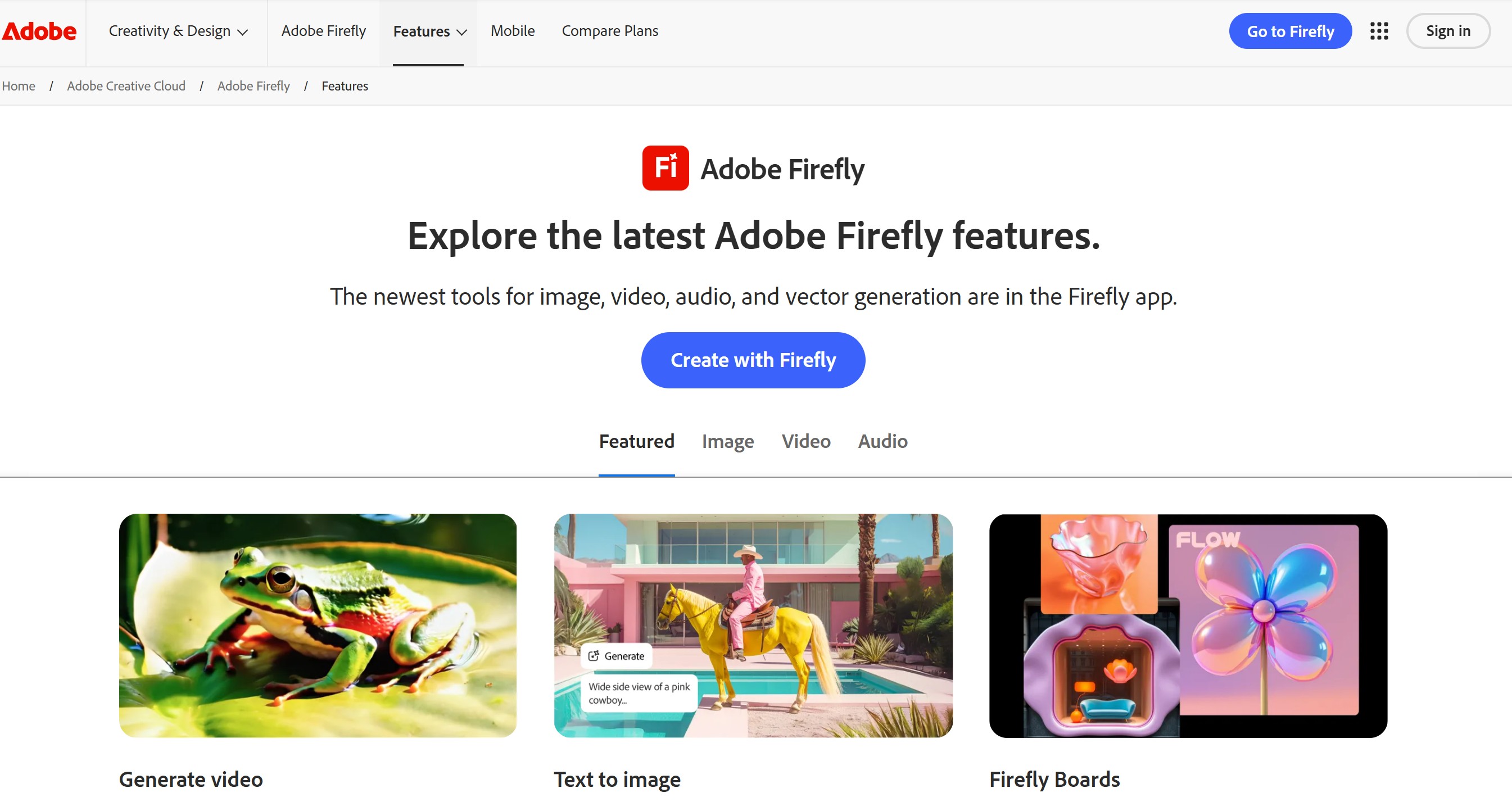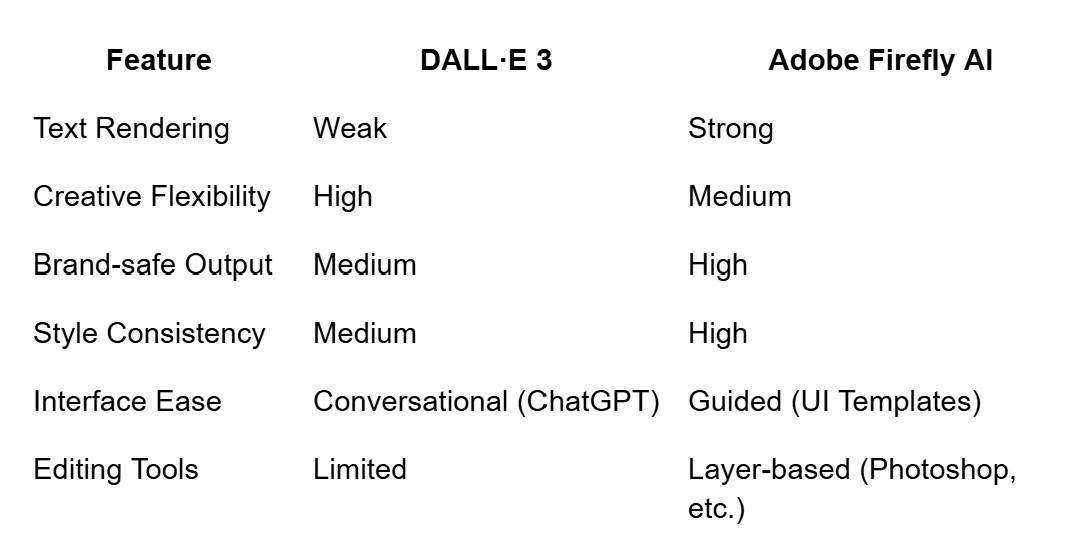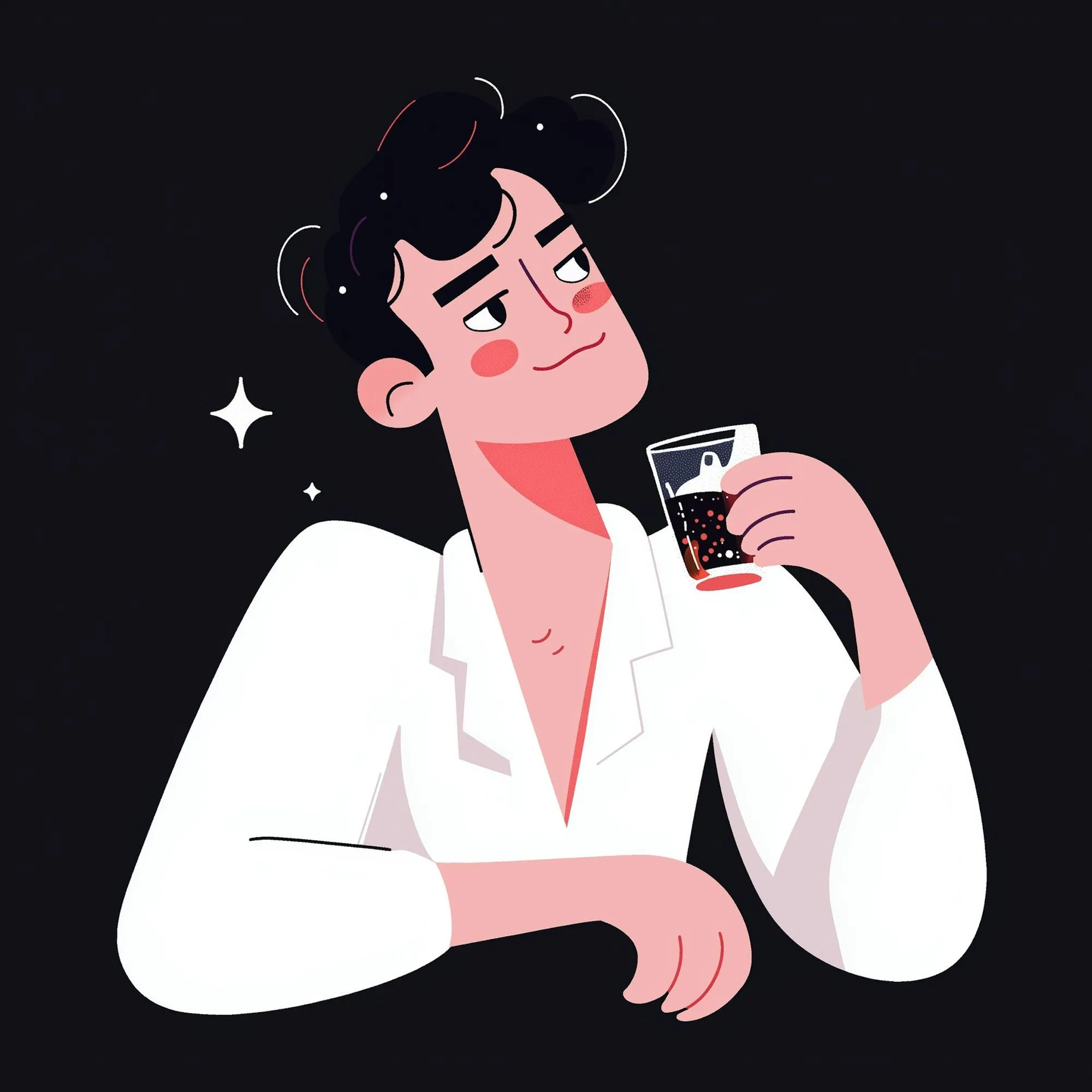DALL·E vs Adobe Firefly (2025): AI Image Generator Comparison for Creators & Brands

AI art has taken a giant leap forward with tools like DALL·E and Adobe Firefly, and many creators are now asking the same question — DALL·E vs Firefly, which one is better?
These two AI image generators stand at the forefront of the generative design landscape, transforming how professionals and hobbyists approach creativity.
From crafting high-fidelity visuals for branding to generating quick social media content, tools like DALL·E 3 and Firefly AI have enabled powerful new workflows.
As someone who regularly uses both tools, I’ve tested them across use cases like concept art, visual storytelling, brand-safe design, and even product visualization.
In this article, we’ll dive into a head-to-head DALL·E vs Adobe Firefly comparison, covering image quality, commercial licensing, usability, and integration.
If you're a designer, marketer, or entrepreneur trying to find the best AI image generator, this guide will help you make an informed decision backed by real-world testing.
1. What Are DALL·E and Adobe Firefly?

DALL·E, created by OpenAI, is a text-to-image generator that uses deep learning to turn prompts into realistic, creative visuals. Currently available through platforms like ChatGPT and OpenAI’s Playground, DALL·E is often praised for its artistic freedom, surreal compositions, and prompt adaptability.
On the other hand, Adobe Firefly is Adobe’s answer to AI art generation, seamlessly integrated with Creative Cloud. Built with a focus on commercial use, brand-safe training data, and design-ready features, Firefly supports marketers, designers, and teams who require output that aligns with copyright-safe expectations.
Both platforms use natural language processing and generative adversarial networks (GANs) or diffusion models. While DALL·E 3 leans toward open creativity and experimental visuals, Firefly caters more toward professionals needing polished, copyright-cleared designs.
DALL·E’s standout advantage lies in imaginative flexibility. You can create surrealist imagery, futuristic mashups, or stylized cartoonish concepts simply by tweaking the language.
Firefly excels in Adobe-native workflows. With deep integration into Photoshop and Illustrator, users can generate variations, remove backgrounds, or add design elements using AI-generated layers.
Another key difference is licensing. DALL·E allows commercial use depending on usage tier, but Adobe Firefly guarantees full commercial licensing even for enterprise-grade campaigns. This makes a huge difference for brand managers and agencies needing compliance-ready content.
In terms of output fidelity, both are competitive. However, Firefly leans more toward crisp, clean illustrations and consistent lighting, while DALL·E produces more dynamic and textured visuals.
If you’re choosing between the two, your selection depends largely on your use case: exploratory creativity vs structured commercial design.
2. DALL·E 3 vs Firefly: Feature-by-Feature Breakdown

Prompt Quality & Output Accuracy
DALL·E excels in interpreting complex, abstract prompts. Firefly is more reliable for literal prompt-to-image generation with minimal hallucination.
Speed & Generation Time
DALL·E outputs faster on average, especially within ChatGPT Plus. Firefly can be slower during peak usage but allows in-canvas editing.
Platform Integration
DALL·E integrates into OpenAI tools, Microsoft Copilot, and ChatGPT. Firefly is embedded into Adobe Photoshop, Express, and Illustrator.
Image Style & Aesthetics
DALL·E produces painterly, surreal, and photorealistic outputs. Firefly offers consistent lighting, compositional balance, and editorial-ready styles.
Commercial Use & Licensing
Adobe Firefly uses licensed stock and training data with commercial guarantees. DALL·E allows commercial use with restrictions in some plans.
Free vs Paid Access
DALL·E offers some free usage but requires ChatGPT Plus ($20/month) for DALL·E 3. Firefly provides limited free generations and bundles more in Creative Cloud plans.
Use Case Strengths:
- DALL·E: concept art, creative storytelling, image expansion, quirky prompts
- Firefly: ad visuals, product mockups, typography design, structured layouts
Ease of Use:
Firefly has a more guided, template-based UI. DALL·E, through ChatGPT, feels more conversational and freeform.
Reliability:
Firefly limits bizarre outputs, favoring polished designs. DALL·E may hallucinate but often produces more imaginative results.
Both tools are improving quickly, and 2025 could bring significant convergence in features.
3. Image Quality and Prompt Accuracy
When it comes to image quality, DALL·E 3 and Adobe Firefly offer compelling but slightly different strengths.
DALL·E creates imaginative, painterly images with deep variation, making it ideal for abstract art, conceptual design, and experimental marketing assets. It handles nuanced and metaphorical prompts quite well, often delivering unexpected but impressive interpretations.
Firefly, meanwhile, focuses on polished results that are immediately usable. The images it generates feature clean lines, consistent lighting, and a clear connection to the original prompt. Its text rendering capabilities are also superior, especially in generating logos or branded content that needs legible words.
Both models understand spatial relationships well, though DALL·E tends to excel in environments and texture realism, while Firefly shines in object clarity and layout consistency.
For designers who require absolute brand alignment, Firefly’s accuracy in visual storytelling and literal prompt execution makes it highly dependable. However, for artists looking to explore the surreal or fantastical, DALL·E remains unmatched in versatility.
4. Licensing, Pricing, and Commercial Use: What You Can and Can’t Do

DALL·E allows users to create images for commercial purposes under its terms of use.
Firefly, in contrast, guarantees full commercial rights across its Adobe ecosystem, making it ideal for agencies and brands.
DALL·E’s licensing depends on your usage plan, especially if you're generating via ChatGPT Pro or API.
Firefly is built on licensed Adobe Stock, open access content, and public domain datasets, ensuring zero copyright conflicts.
Firefly explicitly promotes itself as a “commercial-safe” AI image generator for designers and businesses.
DALL·E encourages creative freedom but suggests caution for large-scale usage in publishing or product distribution without review.
Firefly’s enterprise-grade assurance provides peace of mind for those scaling marketing and branding materials.
DALL·E users creating viral content should double-check licensing if using outputs for product packaging, book covers, or paid ads.
Firefly gives more predictable clarity on what is allowed—ideal for regulated industries like healthcare, finance, or education.
Both tools restrict harmful, explicit, or misleading content generation.
DALL·E’s current usage for commercial purposes is permitted but lacks Adobe’s comprehensive licensing structure.
Firefly comes bundled in Creative Cloud plans, offering more value to Adobe users.
DALL·E 3 is available through ChatGPT Plus at $20/month or via API, depending on volume.
Firefly’s free plan offers 25 credits/month; higher plans start with Creative Cloud subscriptions like Photoshop or Illustrator.
DALL·E credits vary by tool and platform integration, with API pricing based on resolution and image count.
Firefly simplifies pricing through bundled cloud access, making it cost-effective for creatives already within the Adobe suite.
For creators focused on content reuse, Firefly’s legal safeguards may outweigh DALL·E’s flexibility.
In short, Firefly wins on brand safety and commercial ease, while DALL·E thrives in creative openness and cost-effective experimentation.
5. DALL·E vs Firefly: Pros and Cons
DALL·E Pros:
- Highly creative and imaginative.
- Flexible with abstract and surreal prompts.
- Available inside ChatGPT, Copilot, and third-party tools.
- Great for generating concept art and experimental visuals.
DALL·E Cons:
- Text rendering still unreliable.
- Image quality can be inconsistent.
- Licensing terms are vague for large-scale commercial use.
- Less integration with design software.
Firefly Pros:
- Full commercial usage rights guaranteed.
- Clean, polished output perfect for marketing assets.
- Deep integration with Photoshop, Illustrator, Express.
- Excellent at rendering text and consistent layouts.
Firefly Cons:
- Slower at peak times.
- Limited prompt creativity.
- Currently tied to Adobe ecosystem.
- Free version offers limited generations.
Use Case Strengths:
- Use DALL·E for idea generation, storyboarding, surreal design, editorial illustration.
- Use Firefly for eCommerce visuals, branded social content, ad design, pitch decks.
Platform Compatibility:
- DALL·E: Web interface, ChatGPT, Microsoft Copilot, API.
- Firefly: Photoshop, Illustrator, Express, Browser.
Pricing Overview:

Verdict on Pros & Cons:
- Choose DALL·E if your priority is artistic freedom.
- Choose Firefly if your focus is brand safety and polished visual assets.
6. Image Quality & Prompt Interpretation Compared
DALL·E’s outputs often reflect a painterly or textured style that feels fluid and imaginative.
Firefly’s images are cleaner, more structured, and often resemble professionally designed illustrations or stock photography.
Both tools offer prompt-based generation, but they interpret natural language slightly differently.
DALL·E is more forgiving and adventurous, producing layered, unique interpretations even when prompts are vague.
Firefly tends to be literal and safe, which works great for users needing tight brand alignment or template-friendly assets.
DALL·E struggles with typography, sometimes distorting letters or symbols even with simple prompts.
Firefly handles text insertion and graphic overlays effectively, producing outputs that can pass as ad-ready.
In complex scene generation, DALL·E adapts compositionally with more variety.
Firefly favors simplicity and clear object hierarchy, which suits minimalist content.
In terms of resolution, both deliver web-quality images; DALL·E offers some post-processing control via outpainting.
Here’s a quick feature comparison:

If you’re generating one-off campaign visuals, Firefly shines in alignment and polish.
If you’re ideating product concepts or visuals for a story, DALL·E feels more inspiring and less rigid.
7. Which Tool Is Right for You?
Choosing between DALL·E and Adobe Firefly depends on your goals, workflows, and creative freedom needs.
Pick DALL·E if:
- You need variety and stylistic experimentation.
- You want AI inside conversational interfaces like ChatGPT.
- You're experimenting with surreal or illustrative content.
- You're an artist, writer, or visual storyteller.
Pick Firefly if:
- You need brand-safe, commercial-ready output.
- You're already using Adobe Creative Cloud.
- You want reliable text and logo generation.
- You're producing marketing visuals at scale.
Other deciding factors:
- DALL·E is cheaper upfront with Pay-as-you-go API or ChatGPT Plus.
- Firefly offers more ROI if you're already an Adobe subscriber.
- Firefly wins on usability and predictability.
- DALL·E wins on creativity and spontaneous discovery.
Ultimately, for teams, Firefly provides control and integration.
For solo creators or visionaries, DALL·E may unlock ideas Firefly wouldn’t attempt.
Both tools can coexist in the same workflow—use DALL·E to brainstorm and Firefly to finalize.
8. Use Cases: Where DALL·E and Firefly Truly Shine
DALL·E thrives in environments where creativity, narrative flexibility, and experimental concepts drive the vision. Artists, educators, content creators, and marketing teams often turn to DALL·E to prototype surreal scenes, visualize storyboards, or quickly generate diverse visual directions.
It’s especially handy for:
- Concept art and narrative storytelling
- Fantasy illustrations and book covers
- Blog imagery and editorial visuals
- Mood boards and brand brainstorming
Because DALL·E responds well to layered prompts and metaphorical descriptions, it supports imaginative campaigns where the visuals aren't bound by rigid structure.
Adobe Firefly, however, is a powerhouse for content teams and designers needing brand-safe, polished, commercial-ready assets. It’s embedded deeply within Adobe's ecosystem, which makes it ideal for those already working in Photoshop, Illustrator, and Express.
Firefly excels in:
- Ecommerce product visuals and ad mockups
- Social media graphics with integrated text
- Corporate presentation assets
- Marketing campaign visuals at scale
The difference boils down to workflow needs. DALL·E is great when the brief is open-ended. Firefly is perfect when deadlines, branding, and precision are the priority.
Both are robust AI image generators—but the AI-powered design needs of a brand vs. an artist’s need to experiment define their best use cases.
9. Final Verdict: DALL·E vs Firefly
Both DALL·E and Adobe Firefly are industry-leading AI art tools, each serving distinct user profiles and use cases.
DALL·E is a better fit for creatives, writers, educators, and innovators. It brings imagination to life without much constraint, letting you explore wild ideas with a few words. Its integration with ChatGPT also adds conversational fluidity to prompt generation, which is helpful for those less experienced in prompt crafting.
Firefly, in contrast, is purpose-built for designers, marketers, and corporate teams. Its emphasis on commercial-safe outputs, text rendering, and integration with Adobe’s suite makes it extremely efficient for branded content creation.
The real win comes when the two are used together. Use DALL·E to brainstorm and Firefly to finalize. Each plays to its strengths and enhances different parts of the creative process.
So, who wins in the DALL·E vs Firefly showdown? It depends on your creative mission—but both are leaders in their own right.
10. Frequently Asked Questions (FAQs)
Q1: Which tool is more beginner-friendly: DALL·E or Firefly?
A: Firefly is more intuitive for beginners due to its guided templates and integration into Adobe Express. DALL·E is conversational but may need prompt tuning.
Q2: Can I use DALL·E or Firefly images for commercial purposes?
A: Firefly offers fully licensed commercial usage. DALL·E allows it with limitations—read OpenAI’s terms before large-scale use.
Q3: Which AI art tool generates more realistic images?
A: DALL·E can be more creative and detailed, while Firefly tends to generate cleaner, more design-focused imagery.
Q4: Are there free versions of DALL·E and Firefly?
A: Yes. Firefly offers 25 free credits monthly. DALL·E is free in limited form, but full access comes with ChatGPT Plus.
